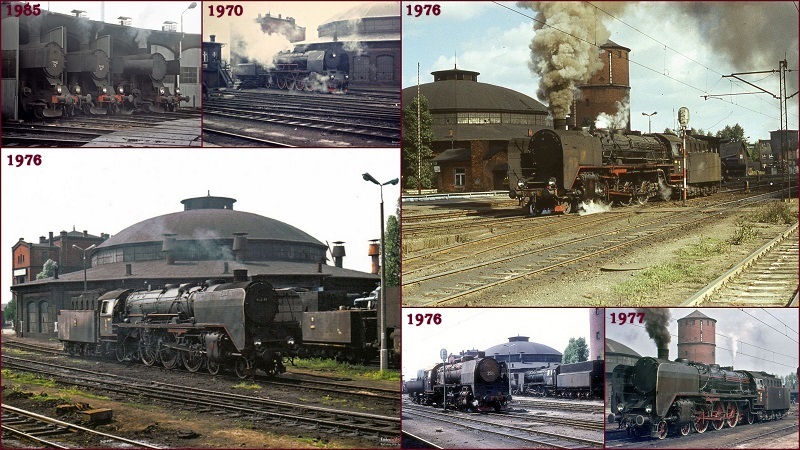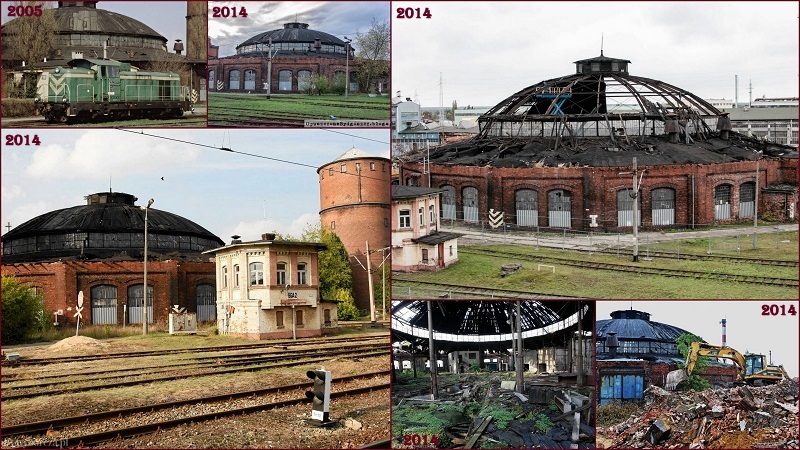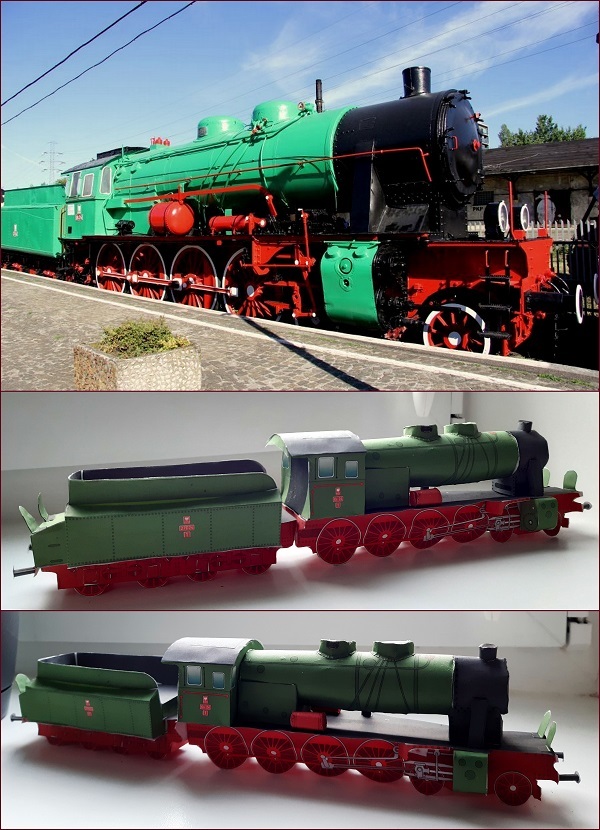
 [PL]
[PL]Bydgoska parowozownia była obiektem unikatowym, ponieważ była jedną z trzech w Polsce i zarazem jedną z sześciu w Europie okrągłych parowozowni systemu Schwedlera. Parowozownię, zwaną także tendrownią, wybudowano w Bydgoszczy w latach 70-tych XIX wieku. Było to związane z budową węzła kolejowego w Bydgoszczy i rozwojem linii kolejowej na trasie z Berlina przez Bydgoszcz do wschodnich rubieży królestwa Prus. Bydgoska parowozownia do 1985 roku zajmowała się naprawą tendrów, czyli wagonów służących do przewozu węgla, które znajdowały się tuż za lokomotywą.

Na wieść o planowanej rozbiórce parowozowni przez pobliski zakład produkujący i remontujący pojazdy szynowe, czyli Pesę, kujawsko-pomorski konserwator zabytków Sambor Gawiński w marcu 2014 roku wpisał parowozownię w Bydgoszczy do rejestru zabytków. W maju 2014 Pesa podjęła decyzję o rozebraniu parowozowni, ale jednocześnie zobowiązano się do zrekonstruowania parowozowni w innym miejscu. W październiku 2014 roku obiekt rozebrano, ale niestety nie ustalono wówczas lokalizacji, w której zrekonstruowano by ten budynek. W listopadzie 2014 roku elementy rozebranej parowozowni zostały przekazano miastu Bydgoszcz. Władze miasta postanowiły odtworzyć budynek najpierw na terenie Exploseum, potem na obszarze Myślęcinka, aż w końcu wszystkie elementy zdeponowano na placu zarządzanym przez miejski zarząd dróg na ul.Witebskiej. Koszt zrekonstruowania bydgoskiej parowozowni w 2018 roku wyniosił prawie 4 mln zł i to głównie z tego powodu do dzisiaj nie udało się jeszcze odbudować tego obiektu.

Skrytka nie znajduje się na współrzędnych początkowych. Aby odnaleźć skrytkę finałową, wykonaj poniższe zadanie. Polega ono na wydrukowaniu modelu parowozu Os-24 wraz z tendrem 27D24-10 oraz na prawidłowym złożeniu tego modelu. Przy składaniu modelu pamiętaj o najważniejszych rzeczach:
- wydrukuj model w kolorze na nieco grubszej kartce od tej, która zalega w podajniku drukarki
- nie sklejaj lokomotywy z tendrem, dzięki czemu nie zasłonisz potrzebnych cyfr
- nie pomyl prawej strony z lewą stroną modelu i na odwrót, bo źle odczytasz współrzędne
- nie wszystkie drobne elementy modelu zawierają cyfry ze współrzędnych, ale polecam złożenie modelu z pełnymi detalami - satysfakcja murowana
- postępuj zgodne z instrukcją – krok po kroku złożysz ten model
- oryginalna lokomotywa parowa Os-24 wraz z tendrem oraz model złożony przeze mnie możesz zobaczyć poniżej

Model do sklejenia wraz z instrukcją znajdziesz w pliku w formacie .pdf (plik jest bezpieczny i wolny od wirusów):
MODEL DO POBRANIA
Po złożeniu modelu, odczytaj z niego współrzędne geograficzne czterech miejsc, w których należy rozwiązać dalszą część zadania. Dzięki temu otrzymasz liczby potrzebne do obliczenie współrzędnych skrytki finałowej.
Lokalizacja 1:
A - Suma cyfr w numerze czarno-szarej lokomotywy
B - Suma cyfr w numerze żółto-szarej lokomotywy
Lokalizacja 2:
C - Suma cyfr w numerze serii lokomotywy
D - Masa lokomotywy wraz z torami (w tonach)
Lokalizacja 3:
E - Suma cyfr w numerze lokomotywy
F - Numer drogi
Lokalizacja 4:
X - Suma cyfr w numerze lokomotywy
Y - Suma cyfr w km na pomniku, który symbolizuje początek/koniec trasy kolejowej
Współrzędne Skrytki Finałowej:
N 53°08.[(A*B)+(C*E)+D-F]'
E 017°59.[(C*Y)+(2*X)+Y-A+1]'
SKRYTKA: śmiało dołącz do swojego wpisu zdjęcie wykonanego przez siebie modelu, ale jednocześnie proszę o zakrycie cyfr na złożonym modelu – nie spoileruj (!), uważaj na mugoli (!), użyj magnesu lub metalowego przedmiotu zawieszonego na sznurku o minimalnej długości 50 cm – bez tego sprzętu nie uda Ci się wyjąć pojemnika z logbookiem (!), nie szarp za maskowanie – jeśli nie masz odpowiedniego sprzętu, wróć po skrytkę po odpowiednim przygotowaniu się (!)
 [EN]
[EN]The circular steam locomotive depot in Bydgoszcz was unique because it was one of three in Poland and one of the six in Europe objects of this type. The steam locomotive depot was built in Bydgoszcz in the 1870s. It was related to the construction of a railway junction in Bydgoszcz and the development of a railway line on the route from Berlin through Bydgoszcz to the eastern border of the kingdom of Prussia. Until 1985, the Bydgoszcz locomotive depot has repaired tenders, i.e. wagons used for transporting coal, which were located right behind the locomotive.
Upon the news of the planned demolition of the steam locomotive depot by the nearby Pesa manufacturing and repair plant, the Kuyavian-Pomeranian Monument Conservator, Sambor Gawiński, put the steam locomotive depot in Bydgoszcz on the register of monuments in March 2014. In May 2014, Pesa decided to demolish the steam locomotive depot, but at the same time undertook to reconstruct the shed elsewhere. In October 2014, the building was demolished, but unfortunately the location where the building would be reconstructed was not established at that time. In November 2014, the elements of the demolished steam locomotive depot were handed over to the city of Bydgoszcz. The city authorities decided to reconstruct the building in the Exploseum area but then they decided to change the location into the Myślęcinek area. Finally, all the elements of the locomotive shed were deposited on the square managed by the municipal road management on Witebska Street. The cost of reconstructing the Bydgoszcz steam locomotive depot in 2018 amounted to almost PLN 4 million and this is mainly why it has not yet been possible to rebuild this facility.
If you want to find the final cache, complete the task below. You have to print a model of the Os-24 locomotive together with tender 27D24-10. Then you have to correctly glue and assemble this model. Remember about the most important things:
- print the model in color on a sheet slightly thicker than the one in the printer's tray
- do not stick the locomotive together with the tender, thanks to which you will not cover the necessary numbers
- do not confuse the right side with the left side of the model and vice versa, because you will misread the coordinates
- not all small elements of the model contain numbers from the coordinates, but I recommend assembling the model with full details – do it just for fun
- follow the instructions - you will assemble this model step by step
The model to be glued together with the instructions can be found in a file in .pdf format (the file is safe and virus-free):
DOWNLOAD THE TRAIN MODEL
After assembling the model, read the coordinates of four places where you need to solve the rest of the task. This will give you the numbers needed to calculate the coordinates of the final cache.
Location 1:
A – Sum of digits in the number of the black-gray locomotive
B - Sum of digits in the number of the yellow-gray locomotive
Location 2:
C - Sum of digits in the serial number of the locomotive
D - Locomotive weight with rails (in tonnes)
Location 3:
E - Sum of digits in the number of the locomotive
F – Road number
Location 4:
X - Sum of digits in the number of the locomotive
Y - Sum of digits in km on the monument which symbolizes the start / end of the railway route
Coordinates of the Final Cache:
N 53°08.[(A*B)+(C*E)+D-F]'
E 017°59.[(C*Y)+(2*X)++Y-A+1]'
CACHE: feel free to include in your log a photo of the model you have made, but at the same time please cover the numbers on the assembled model - do not give any spoilers (!), watch out for Muggles (!), use a magnet or a metal object suspended on a string with a minimum length of 50 cm - without this equipment, you will not be able to pull the container with logbook out (!), do not damage the camouflage - if you do not have the appropriate equipment, go home and come back better prepared (!)

